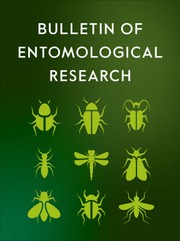No CrossRef data available.
Article contents
Transgenerational effect of Cordyceps fumosorosea (Wize) on demographic parameters and detoxifying enzymes of Spodoptera frugiperda (Smith)
Published online by Cambridge University Press: 02 July 2025
Abstract
Spodoptera frugiperda is a notorious pest that has been recorded attacking over 353 crop species worldwide. Excessive insecticide exposure can lead to resistance and has adverse impacts on the environment and beneficial organisms. Long-lasting pest control methods like entomopathogenic fungi may be used to prevent the negative impact of synthetic insecticides. In the current research, effectiveness of Cordyceps fumosorosea was analysed by applying a sub-lethal dose (LC15 = 2.09 × 106 spores mL−1) and a lethal dose (LC50 = 2.17 × 107 spores mL−1) on filial (F0) and first filial (F1) generations of S. frugiperda to estimate both lethal and sub-lethal effects. The LC15 was used to keep a significant proportion of larvae alive to permit determination of sublethal effects on S. frugiperda. After treatment with the LC15 and LC50, S. frugiperda progeny displayed shorter larval duration, lower fecundity, and shorter adult female and male longevities relative to untreated controls. Likewise, the adult pre-oviposition period, total pre-oviposition period, oviposition days (Od), net reproductive rates (Ro), and mean generation times (T) were reduced in fungal-infected groups. Furthermore, activities of key detoxifying enzymes, i.e. acetylcholinesterase (AChE), glutathione S-transferases (GST), and esterases (EST), were also evaluated. Substantial differences of AChE, GST, and EST (24.3, 18.34, and 10.09 µmol/min/mg protein), respectively, were observed at the LC50 in contrast to the LC15 and controls. The current study showed pathogenicity of C. fumosorosea, which negatively affected insect development and changed the activities of detoxifying enzymes, thereby increasing the effectiveness and eco-friendly management of S. frugiperda.
Keywords
Information
- Type
- Research Paper
- Information
- Copyright
- © The Author(s), 2025. Published by Cambridge University Press.


